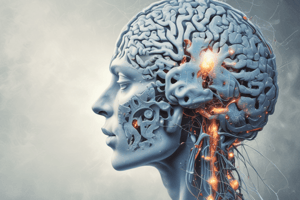Podcast
Questions and Answers
Which of the following is a secondary injury event in traumatic brain injury?
Which of the following is a secondary injury event in traumatic brain injury?
- Sensory deficits
- Severity graded on degree of neurological deficit
- Brain swelling (correct)
- Frontal lobe damage
Which lobe damage in traumatic brain injury is associated with speech problems and inattentiveness?
Which lobe damage in traumatic brain injury is associated with speech problems and inattentiveness?
- Severity graded on degree of neurological deficit
- Parietal lobe damage
- Sensory deficits
- Frontal lobe damage (correct)
What is the common result of severity grading in traumatic brain injury?
What is the common result of severity grading in traumatic brain injury?
- Brain swelling
- Infection inside the skull
- Degree of neurological deficit resulting from injury (correct)
- Sensory deficits
What is the gender ratio for TBI, largely thought to be related to risk-taking behavior among young males?
What is the gender ratio for TBI, largely thought to be related to risk-taking behavior among young males?
What percentage of the adult and pediatric NSW BIRP populations have 1 or more challenging behaviors following TBI?
What percentage of the adult and pediatric NSW BIRP populations have 1 or more challenging behaviors following TBI?
What is the average employment rate post TBI?
What is the average employment rate post TBI?
What is the primary injury in TBI according to the text?
What is the primary injury in TBI according to the text?
Which of the following is a secondary injury event in traumatic brain injury?
Which of the following is a secondary injury event in traumatic brain injury?
What is the location associated with sensory deficits in traumatic brain injury?
What is the location associated with sensory deficits in traumatic brain injury?
How is the severity of traumatic brain injury graded?
How is the severity of traumatic brain injury graded?
What percentage of the adult and pediatric NSW BIRP populations have 1 or more challenging behaviors following TBI?
What percentage of the adult and pediatric NSW BIRP populations have 1 or more challenging behaviors following TBI?
What is the gender ratio for TBI, largely thought to be related to risk-taking behavior among young males?
What is the gender ratio for TBI, largely thought to be related to risk-taking behavior among young males?
What is the average employment rate post TBI?
What is the average employment rate post TBI?
What is the primary injury in TBI according to the text?
What is the primary injury in TBI according to the text?
Flashcards are hidden until you start studying
Study Notes
Traumatic Brain Injury (TBI) Overview
- Secondary injury events include processes such as inflammation, edema, and hypoxia that exacerbate initial trauma.
- Damage to the frontal lobe is associated with speech problems and inattentiveness.
- Severity grading in TBI typically results in classifications as mild, moderate, or severe based on clinical examination and imaging.
Demographics and Statistics
- The gender ratio for TBI is often cited as 3:1 (males to females), influenced by risk-taking behaviors predominantly observed in young males.
- Approximately 60% of both adult and pediatric populations in New South Wales (NSW) Brain Injury Rehabilitation Programs (BIRP) experience one or more challenging behaviors following TBI.
- Post-TBI employment rates average around 40%, significantly affected by the severity of injury and associated cognitive challenges.
Types of Injuries
- Primary injuries in TBI arise from the initial blunt trauma or penetration that causes immediate tissue damage.
- Sensory deficits in TBI are linked to damage in the parietal lobe, which processes sensory information.
Severity Assessment
- TBI severity is graded based on the Glasgow Coma Scale (GCS) which assesses consciousness levels, allowing for a structured evaluation of injury extent.
Studying That Suits You
Use AI to generate personalized quizzes and flashcards to suit your learning preferences.




